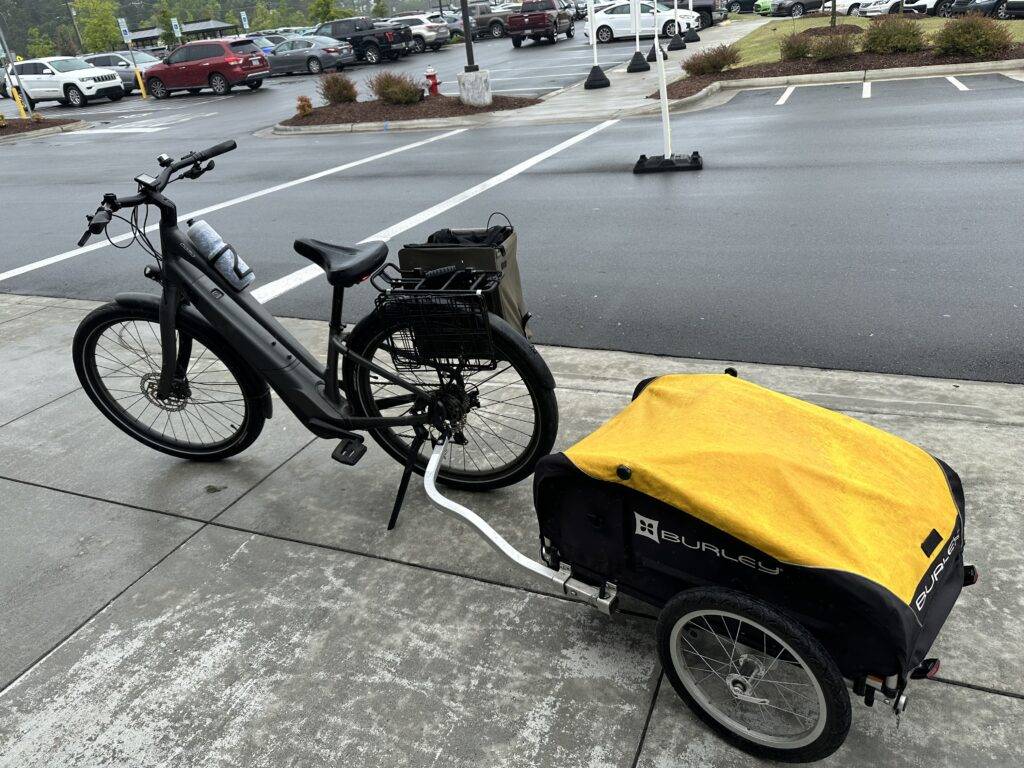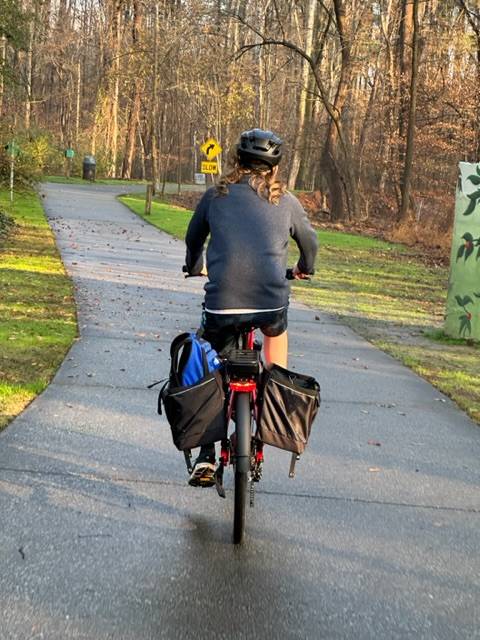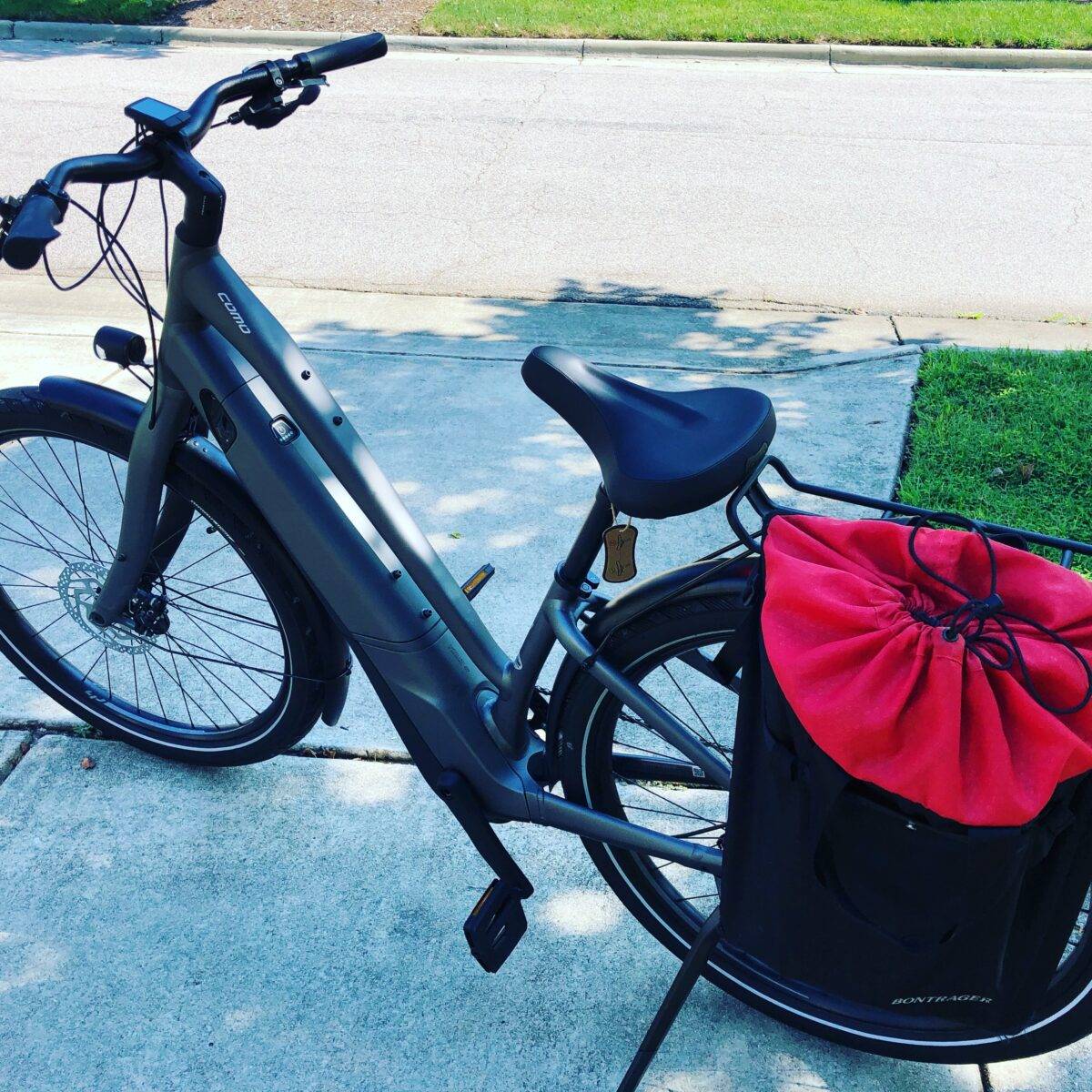Meandering around Chapel Hill, it is hard to miss the plethora of hybrid, plug-in hybrids, and electric cars in driveways, shopping centers, and parked on the street. On just about every block you’ll see a Tesla, which may have displaced Toyota’s Prius as the favored vehicle of the town’s environmental set.
But while electric cars and hybrids are a lot better than traditional Internal Combustion Engine (ICE) cars powered by gas or diesel, they are not panaceas for the environment. When you drive in your 4,000 pound electric car, you’re lugging around a lot of wasted weight, and that means it takes a lot of energy to get from Point A to Point B. It’s more efficient than an ICE to be sure but it’s still a lot of energy being used to move you around, and much of that is coming from dirty sources like coal or natural gas.
The real climate-efficient way to move around is a variant on one of the oldest human-power modes of transportation, the bicycle. Electric bikes are transformative. They are lightweight, and relatively inexpensive, and make it easy to travel short and medium distances. You can pedal like on a normal bike, and the electric motor kicks in and gives you a boost. It’s just like riding a bike, but easier. With an e-bike, the hills of Chapel Hill are not a deterrent. They are the perfect mode for shorter trips of a few miles.
What’s an electric bike, anyway?
Let’s back up a bit and provide a little background. When I say “electric bike,” what I’m talking about is an “electric-assist bike.”
Electric-assist bikes are regular bikes that have an electric motor that assists the rider (hence the name). Electric-assist bikes typically do not have throttles (although there are electric bikes with throttles). If you want to engage the motor, you need to pedal. The electric motor only kicks in once you start pedaling. Most bikes allow you to adjust the power level through a switch on the bike and through a cell phone app, so that you have incredible flexibility to bike as hard as you want.
Going on flat ground and want to work up a bit of a sweat? You can put the assist on its lowest setting. Heading up a hill on the way to work in your nice button-down shirt and slacks? You can move to maximum assist and let the motor do most of the work. If you’re going downhill, you can let gravity do the work and turn the electric assist off altogether.
Electric assist bikes are available from a wide range of manufacturers; in Chapel Hill, you can test them out and purchase them at most stores that sell bicycles. Check out our e-bike guide for more.
The efficiency of an electric bike
Electric bikes make it possible to easily travel around town for less than a penny per day — literally.
I purchased my e-bike in 2019, and since then I’ve been regularly evaluating its efficiency in comparison to other transportation modes like driving a car. My e-bike tracks the number of times I do a full charge-discharge cycle of my 504 watt-hour (0.5 kilowatt hour, or kWh) battery, and I have been recording that information every 500 miles. With this data I can calculate about how much electricity I have used overall, and I can track the average amount of electricity expended to travel a mile. (It can differ from mile to mile, depending on how much electric assist I use.) In addition, since I know how many watt-hours I’ve expended, I can calculate the cost of the electricity that I’ve used to charge the battery based on Duke Energy’s standard rates.

The numbers are pretty incredible. The table below is the data I’ve collected from my nearly four years of ebike riding.
| Miles | Watt-hours | Cost per mile | Total cost |
|---|---|---|---|
| 500 | 5,040 | 0.09 cents | $0.47 |
| 1,000 | 13,104 | 0.12 cents | $1.23 |
| 1,500 | 16,632 | 0.10 cents | $1.56 |
| 2,000 | 21,672 | 0.10 cents | $2.03 |
| 2,500 | 26,712 | 0.10 cents | $2.51 |
| 3,000 | 33,264 | 0.11 cents | $3.12 |
| 3,500 | 39,312 | 0.11 cents | $3.69 |
| 4,000 | 45,864 | 0.11 cents | $4.30 |
| 4,500 | 52,416 | 0.11 cents | $4.92 |
After traveling 4,500 miles, I have spent less than $5 on electricity. Five dollars! That’s less than a cost of a mocha latte something at Starbucks. That is astounding. That’s less than the cost of two gallons of gas. It means that on days I bike the 10 miles to and from work, I’m spending less than one cent on electricity to get there. And about half the time, I’m carting a bike cargo trailer behind me (often full of groceries) which means it’s a heavier load for the bike to carry.
Some look at Electric Vehicles (EVs) as the solution to our climate change problems, but there’s really no comparison. One of the most efficient EVs available today is the Tesla Model 3. It can travel around 3.2 miles per kwH. In other words, it needs to use about 312 watt-hours to travel one mile. By comparison, over 4,500 miles my ebike has used about 11.7 watt-hours for each mile. That means the e-bike uses less than 4% as much electricity as the EV. While the Tesla needs to use 1 kilowatt hour of electricity to travel just over three miles, my e-bike uses 1 kilowatt hour of electricity to travel more than 85 miles. The $4.92 I’ve spent on electricity to travel 4,500 miles would move the Tesla 167 miles (and a normal ICE vehicle about 50-60 miles).
And remember, the Model 3 is the most efficient EV on the market today. Larger, heavier vehicles don’t do as well. A Ford F-150 Lightning can’t even go two miles on 1 kilowatt hour, and so the e-bike is more than 40 times more efficient.
These efficiency measures don’t capture some of the other ways electric bikes are better for our environment. E-bikes don’t require large amounts of land for parking, such as the multi-million dollar parking deck being built downtown and the large parking deck that comprises a large part of the cost of Carrboro’s new library.
An under-reported source of pollution from cars comes from their tires, and because they are heavier, EVs cause even more tire pollution. Moreover, electric bikes are significantly lighter and less complex, and so require exponentially fewer raw materials to construct than electric cars. It’s a lot less environmental impact to build my ebike’s 0.5 kwH battery than the GMC Hummer’s 212 kWh battery.

Plus, they’re fun to ride! I know many people who were skeptical of electric bikes and didn’t see the point, until they tried them and started pedaling up steep hills without breaking a sweat. They were quick converts. And, unlike driving a car, you do get exercise.
No, an e-bike is not going to get you to the beach. You’re not going to be able to transport a couch sectional. And it won’t work for your six-kid carpool to the soccer game. But there is no reason that a single vehicle needs to accomplish every transportation need. Use the car for the carpool, and use the e-bike for shorter trips in-town, to the pharmacy, out to dinner, to meet friends, or even to the grocery store, You’d be amazed what you can carry with the right equipment.
And, maybe you can make it work that you transition a two-car household to one car and an e-bike. You’ll come out far ahead. It’ll be better for your health. (And more people riding bikes means that there’s less car traffic on the road – so if you aren’t able to ride a bike or have a commute that doesn’t allow one, you still benefit from having more people ride bikes in your community.)
Electric bikes are the economical choice
Electric bikes are much less costly than a car and the ongoing costs are significantly less. My bike cost about $3,500, although today you can get high quality e-bikes for less than $2,000. Cargo e-bikes (which can often accommodate a second person on the back) cost more.
And since then, the cost of upkeep has been minimal I’ve paid $0 in registration fees to the DMV, and $0 in property taxes. I haven’t had to pay an annual fee to get my bike inspected, or wait in line at the Jiffy Lube. There are no costly oil changes or tire rotations. I’m not paying hundreds of dollars per year on car insurance. And maintenance costs have been minimal. I have had to get the chain and brake pads replaced a couple of times, and fix a flat tire, but total maintenance costs have been less than $400. I purchased my bike at The Bicycle Chain, and as part of that I get a lot of regular maintenance for free, which is helpful. So even though I have no mechanical skills, it has not been expensive to keep the bike going.
There are other impediments to using an electric bike to accomplish daily trips. While the town is trying hard, our current network of greenways and bike trails continues to have some significant gaps. For most routes you’ll need to mix with car traffic. In many cases, though, the routes take you on local neighborhood roads with cars that drive slowly, and the electric assist that e-bikes provide make it easy to travel at a comfortable pace. And the more that you ride your bike, the more comfortable you’ll get. (An understated benefit of electric bikes is that in mixed traffic they allow you to keep up better with car traffic, improving safety and reducing the amount of time you need to spend on roads with no bike facilities)

Sign up for the Carrboro Linear Parks Project mailing list to get updates on building out Carrboro’s greenway network. Visit the Carrboro Linear Parks Project website for more information. There’s also a helpful FAQ with answers to many questions.
Update: We support the creekside alignment for the reasons detailed here.
Plus, there is often an annoying lack of bike parking at your destination, so you’ll be chaining your bike to a no parking sign or a cart corral. (Looking at you Harris Teeter!)
But, ultimately, these drawbacks are annoyances, not reasons to forego riding an e-bike. They do not detract from the joy of e-bike riding or the undeniable environmental and economic benefits. There’s a reason electric bike sales are booming. So give them a try.

